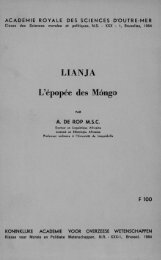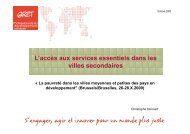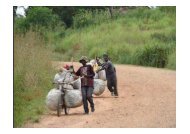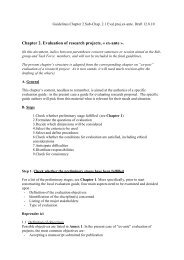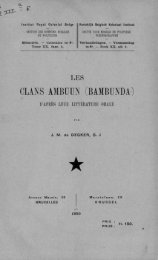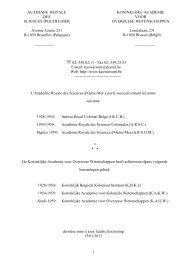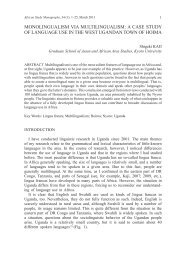bulletin des séances mededelingen der zittingen - Royal Academy ...
bulletin des séances mededelingen der zittingen - Royal Academy ...
bulletin des séances mededelingen der zittingen - Royal Academy ...
You also want an ePaper? Increase the reach of your titles
YUMPU automatically turns print PDFs into web optimized ePapers that Google loves.
a result of research in many countries, is recognised as a major cause of our inability<br />
to improve livestock in the tropics in view of its devastation effects on introduced<br />
breeds and their progeny. My main reason for mentioning this disease, is to bring<br />
to your attention the influence that Professor Vanbreuseghem has had in the<br />
veterinary field encouraging veterinarians and mycologists alike, to look at animal<br />
mycoses as parallels to human infection in both pathogenesis and in epidemiology.<br />
I cannot think of any other medical man other than Sabouraud himself, who has<br />
acted in such an influential way ; my digression is purely out of admiration.<br />
In talking about «Aerobiology and Allergy» I should perhaps say that it is new<br />
ground for us both and as big a subject to develop as medical and veterinary<br />
mycology has proved since the opening up of this subject by the late and lamented<br />
Chester Emmons and Norman Conant. I hope I can point out that we have a very<br />
long way to go before we have a store of knowledge comparable to what one might<br />
term «terrabiology» with its data-bank great enough in the natural history of<br />
ringworm fungi, for instance, to give us so sophisticated a symposium on their<br />
mating habits as was eloquently documented un<strong>der</strong> Professor Vanbreuseghem and<br />
Doctor de Vroey in 1983.<br />
The air is something that we all have to breathe but consi<strong>der</strong>ing this, it has hardly<br />
received the attention as to its quality that a staple of life <strong>des</strong>erves ; food is subject<br />
to all manner of regulations, water is too, to ensure its purity, but air is only<br />
consi<strong>der</strong>ed polluted by man-made pollutants - through fires, motor cars and<br />
industry which are shown medically and politically to impair health. Why is it then<br />
that biological pollutants hazardous to health have been virtually ignored until very<br />
recently ? - perhaps the answer lies in the old adage «what the eye does not see the<br />
heart does not grieve over». What we really need to do is to look at great detail into<br />
what is exactly in the air : its nature and complexity ; how much there is of it ; when<br />
and where it is there ; and what is its medical and veterinary significance. I leave the<br />
plant pathological aspects to the later paper today by Professor Semal.<br />
There are, in aerobiology, some unfortunate fundamental conflicts, mostly based<br />
on a lack of un<strong>der</strong>standing. One is that between the medical and non-medical<br />
investigator, coming from opposite directions and often failing to meet on common<br />
ground. Plant pathologists rightly dominate airborne disease forecasting with their<br />
intimate knowledge of the movement of airborne spores between countries and<br />
continents ; pollen analysts look after the hay-fever aspects, whilst the physician<br />
deals with the domestic (indoor) allergies. Moreover, there is also conflict in allergy<br />
itself between the respiratory allergist - basing his diagnostic techniques on those<br />
devised by the scientific investigations of prof. Jack Pepys and his immunologist<br />
colleague, Dr. Joan Longbottom, from the 1960s at the Cardiothoracic Institute at<br />
the brompton Hospital, London, and the alimentary allergist working until recently,<br />
purely on the trial and error of dietary exclusion.<br />
Those who study aerobiology are also divided by their interest in «viable»<br />
(infective) particles and «non-viable» (non-infective) ones, with little un<strong>der</strong>standing






